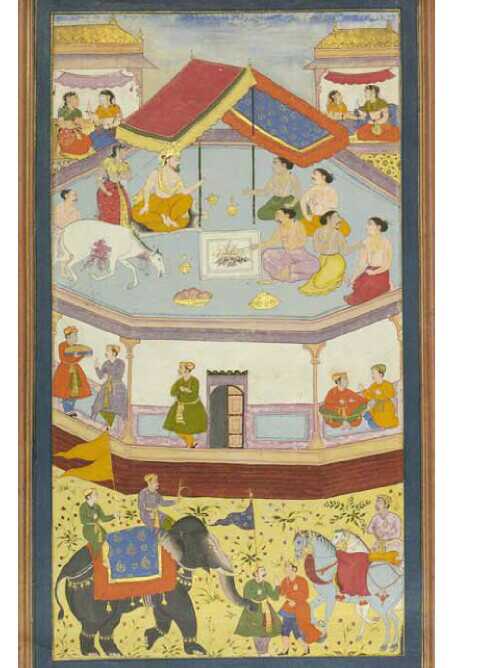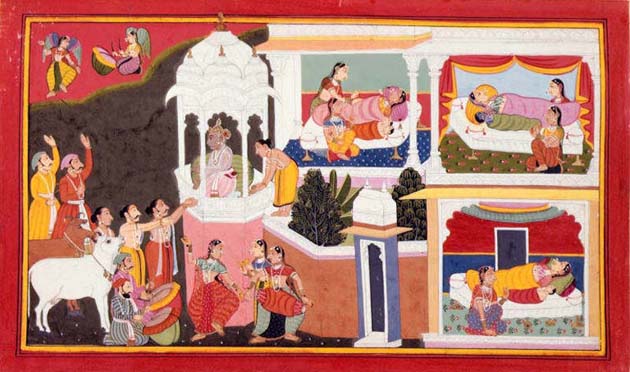|
Pariar
Pariyar, also spelled Pariar, is a village in Sikandarpur Sarausi block of Unnao district, Uttar Pradesh, India. It is located on the left bank of the Ganges, 23km northwest of the city of Unnao. Nearby the village is the Mahua lake. Pariyar holds religious significance to Hindus; it is considered to be the place where the goddess Sita was exiled to, and the birthplace of her two sons Lava (Ramayana), Lava and Kusha (Ramayana), Kusha. The village is known for holding a major fair during the month of Kartik (month), Kartika, on Purnima, the day of the full moon, which is attended by over 100,000 people. Historically, Pariyar was the seat of a pargana since 1785, and under the Nawabs of Awadh it was the seat of a tehsildar. Today, it is the headquarters of a nyaya panchayat. Pariyar is connected by road with Mohan, Uttar Pradesh, Mohan and Rasulabad. As of 2011, its population is 7,363, in 1,355 households. Name, history, and legends According to legend, Pariyar is the place wher ... [...More Info...] [...Related Items...] OR: [Wikipedia] [Google] [Baidu] |
Unnao District
Unnao district is a district of Uttar Pradesh state in northern India. The city of Unnao is the district headquarters. The district is part of Lucknow Division. As of the 2011 census, Unnao district has a population of 3,108,367, making it the 31st-most populous district in Uttar Pradesh. It is a predominantly rural district, with over 80% of the population living in rural areas. Unnao District is known as "The Land Of Pen and Sword" (कलम और तलवार की धरती). History Unnao district was created by the British upon their annexation of Oudh State in February 1856. Before then, under the Nawabs of Awadh, the area was divided between several different districts or : Purwa covered the eastern part, and to the north were Rasulabad and Safipur. The pargana of Auras, meanwhile, was part of the chakla of Sandila, and the parganas of Baiswara were included in the chakla of the same name, whose headquarters were at Rae Bareli. After the British takeov ... [...More Info...] [...Related Items...] OR: [Wikipedia] [Google] [Baidu] |
States And Territories Of India
India is a federal union comprising 28 states and 8 union territories, with a total of 36 entities. The states and union territories are further subdivided into districts and smaller administrative divisions. History Pre-independence The Indian subcontinent has been ruled by many different ethnic groups throughout its history, each instituting their own policies of administrative division in the region. The British Raj mostly retained the administrative structure of the preceding Mughal Empire. India was divided into provinces (also called Presidencies), directly governed by the British, and princely states, which were nominally controlled by a local prince or raja loyal to the British Empire, which held '' de facto'' sovereignty ( suzerainty) over the princely states. 1947–1950 Between 1947 and 1950 the territories of the princely states were politically integrated into the Indian union. Most were merged into existing provinces; others were organi ... [...More Info...] [...Related Items...] OR: [Wikipedia] [Google] [Baidu] |
Nawabs Of Awadh
The Nawab of Awadh or the Nawab of Oudh was the title of the rulers who governed the state of Awadh (anglicised as Oudh) in north India during the 18th and 19th centuries. The Nawabs of Awadh belonged to a dynasty of Persian origin from Nishapur, Iran.''Encyclopædia Iranica'' R. B. Barnett In 1724, Nawab Saadat Ali Khan I, Sa'adat Khan established the Oudh State with their capital in Faizabad and Lucknow. History The Nawabs of Awadh were semi-autonomous rulers within the fragmented polities of Mughal India after the death in 1707 of Aurangzeb. They fought wars with the Peshwa, the Battle of Bhopal (1737) against the Maratha Confederacy (which was opposed to the Mughal Empire), and the Battle of Karnal (1739) as courtiers of the "Great Moghul". The Nawabs of Awadh, along with many other Nawabs, were regarded as members of the nobility of the greater Mughal Empire. They joined Ahmad Shah Durrani during the Third Battle of Panipat (1761) and restored Shah Alam II ( and 178 ... [...More Info...] [...Related Items...] OR: [Wikipedia] [Google] [Baidu] |
Zamindar
A zamindar ( Hindustani: Devanagari: , ; Persian: , ) in the Indian subcontinent was an autonomous or semiautonomous ruler of a province. The term itself came into use during the reign of Mughals and later the British had begun using it as a native synonym for “estate”. The term means ''land owner'' in Persian. Typically hereditary, from whom they reserved the right to collect tax on behalf of imperial courts or for military purposes. During the period of British colonial rule in India many wealthy and influential zamindars were bestowed with princely and royal titles such as ''maharaja'' (great king), ''raja/rai'' (king) and ''nawab''. During the Mughal Empire, zamindars belonged to the nobility and formed the ruling class. Emperor Akbar granted them mansabs and their ancestral domains were treated as jagirs. Some zamindars who were Hindu by religion and brahmin or kayastha or kshatriya by caste were converted into Muslims by the Mughals. During the colonial era, the ... [...More Info...] [...Related Items...] OR: [Wikipedia] [Google] [Baidu] |
Lunia (caste)
Lunia may refer to: * Lunia: Record of Lunia War, a 2008 video game * Lunia (Dungeons & Dragons), the first layer of Mount Celestia in Dungeons & Dragons {{disambig ... [...More Info...] [...Related Items...] OR: [Wikipedia] [Google] [Baidu] |
Dikhit
Rajput (from Sanskrit ''raja-putra'' 'son of a king') is a large multi-component cluster of castes, kin bodies, and local groups, sharing social status and ideology of genealogical descent originating from the Indian subcontinent. The term Rajput covers various patrilineal clans historically associated with warriorhood: several clans claim Rajput status, although not all claims are universally accepted. According to modern scholars, almost all Rajput clans originated from peasant or pastoral communities. Over time, the Rajputs emerged as a social class comprising people from a variety of ethnic and geographical backgrounds. During the 16th and 17th centuries, the membership of this class became largely hereditary, although new claims to Rajput status continued to be made in the later centuries. Several Rajput-ruled kingdoms played a significant role in many regions of central and northern India from seventh century onwards. The Rajput population and the former Rajput states ... [...More Info...] [...Related Items...] OR: [Wikipedia] [Google] [Baidu] |
Ashvamedha
The Ashvamedha ( sa, अश्वमेध, aśvamedha, translit-std=IAST) was a horse sacrifice ritual followed by the Śrauta tradition of Vedic religion. It was used by ancient Indian kings to prove their imperial sovereignty: a horse accompanied by the king's warriors would be released to wander for a year. In the territory traversed by the horse, any rival could dispute the king's authority by challenging the warriors accompanying it. After one year, if no enemy had managed to kill or capture the horse, the animal would be guided back to the king's capital. It would be then sacrificed, and the king would be declared as an undisputed sovereign. The best-known text describing the sacrifice is the '' Ashvamedhika Parva'' ( sa, अश्वमेध पर्व), or the "Book of Horse Sacrifice," the fourteenth of eighteen books of the Indian epic poem ''Mahabharata''. Krishna and Vyasa advise King Yudhishthira to perform the sacrifice, which is described at great length. ... [...More Info...] [...Related Items...] OR: [Wikipedia] [Google] [Baidu] |
Valmiki
Valmiki (; Sanskrit: वाल्मीकि, ) is celebrated as the harbinger-poet in Sanskrit literature. The epic ''Ramayana'', dated variously from the 5th century BCE to first century BCE, is attributed to him, based on the attribution in the text itself. He is revered as ''Ādi Kavi'', the first poet, author of ''Ramayana'', the first epic poem. The ''Ramayana'', originally written by Valmiki, consists of 24,000 shlokas and seven cantos (kaṇḍas). The is composed of about 480,002 words, being a quarter of the length of the full text of the ''Mahabharata'' or about four times the length of the ''Iliad''. The ''Ramayana'' tells the story of a prince, Rama of the city of Ayodhya in the Kingdom of Kosala, whose wife Sita is abducted by Ravana, the demon-king (Rakshasa) of Lanka. Valmiki's ''Ramayana'' is dated variously from 500 BCE to 100 BCE or about co-eval with early versions of the ''Mahabharata''. As with many traditional epics, it has gone through a process o ... [...More Info...] [...Related Items...] OR: [Wikipedia] [Google] [Baidu] |
Sanskrit
Sanskrit (; attributively , ; nominally , , ) is a classical language belonging to the Indo-Aryan branch of the Indo-European languages. It arose in South Asia after its predecessor languages had diffused there from the northwest in the late Bronze Age. Sanskrit is the sacred language of Hinduism, the language of classical Hindu philosophy, and of historical texts of Buddhism and Jainism. It was a link language in ancient and medieval South Asia, and upon transmission of Hindu and Buddhist culture to Southeast Asia, East Asia and Central Asia in the early medieval era, it became a language of religion and high culture, and of the political elites in some of these regions. As a result, Sanskrit had a lasting impact on the languages of South Asia, Southeast Asia and East Asia, especially in their formal and learned vocabularies. Sanskrit generally connotes several Old Indo-Aryan language varieties. The most archaic of these is the Vedic Sanskrit found in the Rig Veda, a colle ... [...More Info...] [...Related Items...] OR: [Wikipedia] [Google] [Baidu] |
Rama
Rama (; ), Ram, Raman or Ramar, also known as Ramachandra (; , ), is a major deity in Hinduism. He is the seventh and one of the most popular '' avatars'' of Vishnu. In Rama-centric traditions of Hinduism, he is considered the Supreme Being. Rama is said to have been born to Kaushalya and Dasharatha in Ayodhya, the ruler of the Kingdom of Kosala. His siblings included Lakshmana, Bharata, and Shatrughna. He married Sita. Though born in a royal family, their life is described in the Hindu texts as one challenged by unexpected changes such as an exile into impoverished and difficult circumstances, ethical questions and moral dilemmas. Of all their travails, the most notable is the kidnapping of Sita by demon-king Ravana, followed by the determined and epic efforts of Rama and Lakshmana to gain her freedom and destroy the evil Ravana against great odds. The entire life story of Rama, Sita and their companions allegorically discusses duties, rights and social responsibil ... [...More Info...] [...Related Items...] OR: [Wikipedia] [Google] [Baidu] |
Lakshmana
Lakshmana ( sa, लक्ष्मण, lit=the fortunate one, translit=Lakṣmaṇa), also spelled as Laxmana, is the younger brother of Rama and his loyalist in the Hindu epic ''Ramayana''. He bears the epithets of Saumitra () and Ramanuja (). He is the twin of Shatrughna. Legend Birth and marriage King Dasharatha of Ayodhya had three wives: Kausalya, Kaikeyi, and Sumitra. He performed a sacrifice to beget sons and as a result, his queens became pregnant. Lakshmana and his brother Shatrughna were born to Sumitra, while Rama and Bharata were born to Kausalya and Kaikeyi. In the Puranas, Lakshmana is described as an incarnation of Shesha, the multiple-headed naga (serpent) upon whom rests the preserver deity Vishnu, whose avatar Rama is considered to be. When sage Vishvamitra asked Rama to kill the demons in the forest, Lakshmana accompanied them and went to Mithila with them. Lakshmana was especially attached to Rama. When Rama married Sita, Lakshmana married S ... [...More Info...] [...Related Items...] OR: [Wikipedia] [Google] [Baidu] |








